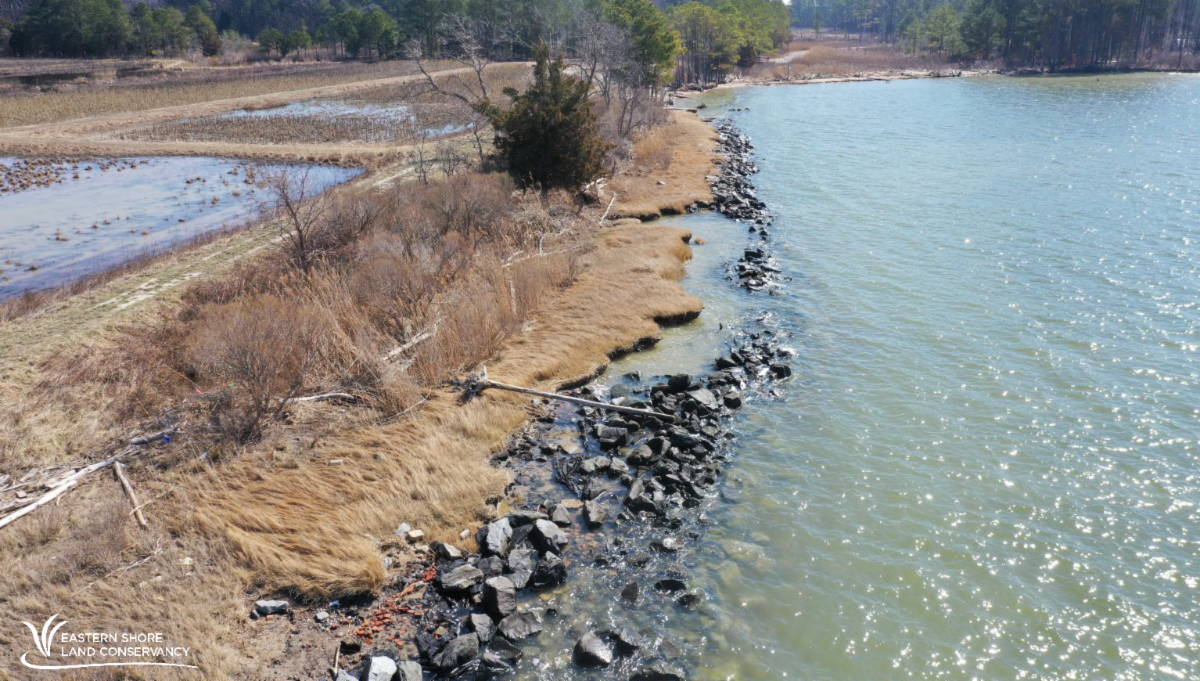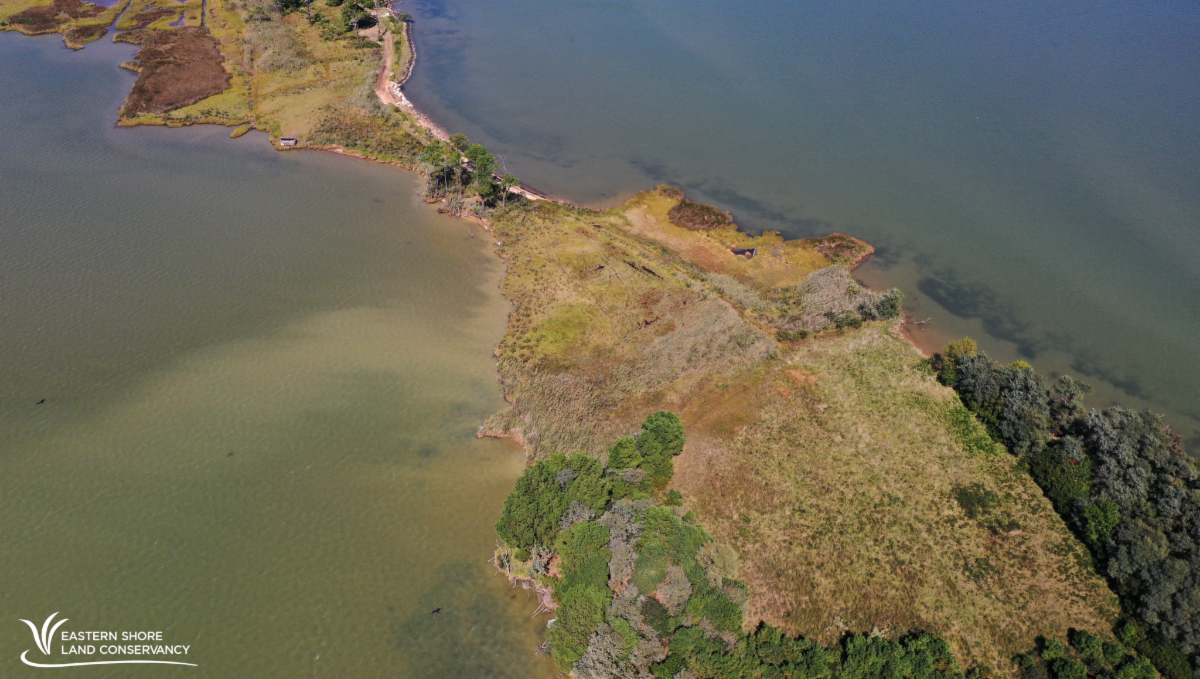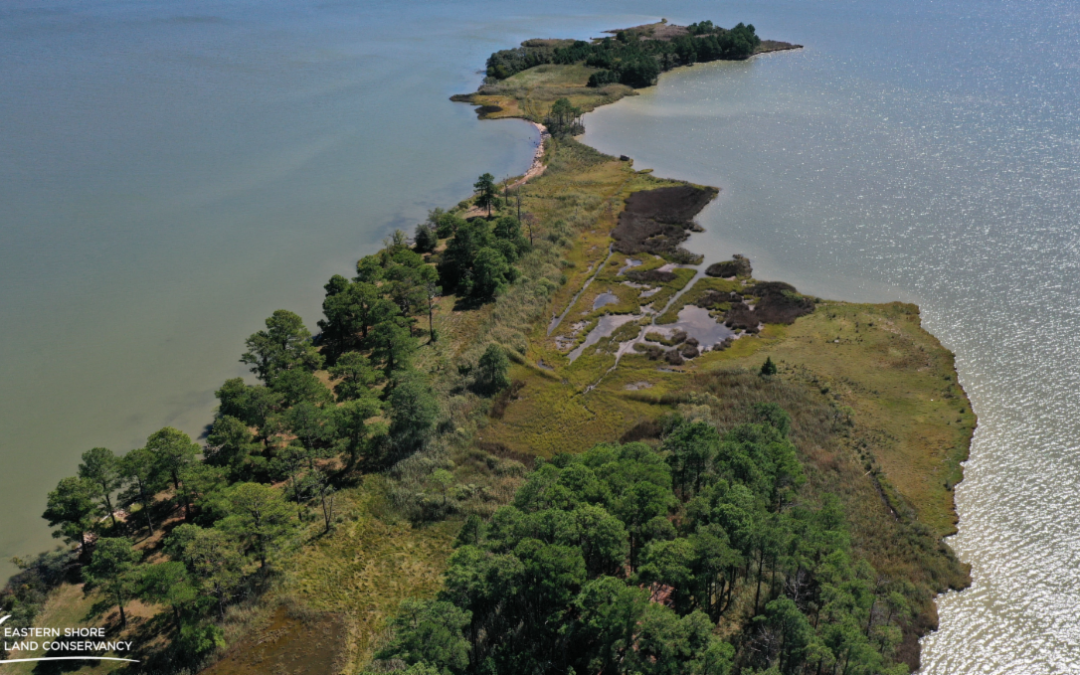Eastern Shore Land Conservancy Drone Photo of South Dorchester
By Jamal Childs
Land conservation in its various forms has emerged as a powerful tool in the fight against climate change. This strategy involves permanently safeguarding natural areas, forest, wetlands and other critical habitats from development and degradation. By doing so, it not only preserves biodiversity but also serves as a vital means of sequestering carbon dioxide, reducing greenhouse gas emissions and mitigating the effects of a changing climate. Sea level rise is dramatically altering property lines along coastal areas like Hoopers Island—a small community in Dorchester County, Maryland—which is a stark reminder of the profound impact of climate change on our communities. As sea levels continue to surge, the once-stable boundaries of homes and land are shifting, often imperceptibly, but with far-reaching consequences.
Residents around the Bay, especially in places like Hoopers Island, are witnessing their cherished properties slowly succumbing to the encroaching waters, leading to not only financial losses but also a deep emotional toll. The urgent need for adaptation strategies and sustainable development practices in these vulnerable coastal regions is becoming increasingly evident as the island’s very existence hangs in the balance. The situation serves as a poignant symbol of the global challenge posed by sea level rise, calling for concerted efforts to mitigate its effect and safeguard our coastal communities for future generations.
Home to roughly 400 people, the Hoopers Island community includes crabbers and fishermen. For generations, they have carved out their livelihoods from the bountiful waters of the Chesapeake Bay, relying on the sea’s abundance to support their families and preserve their way of life. Sadly, the rising tides are changing everything.
While this Lightning Update focuses on Hoopers Island, the island is not alone in its struggles against sea level rise. To the southeast, Deal Island is the subject of the recently released documentary, Eroding History, “a film that tells the story of two Black communities on Deal Island that are in danger of losing their history and culture due to rising seas, and how they are fighting to hold on to what remains.”
Dorchester County is under threat more than most communities in the Chesapeake Bay region due to its low elevation relative to the sea. Some projections have shown that half of the county could be underwater in 50 years due to sea level rise. The people of Hoopers Island continue to feel this threat in their day-to-day lives, as their island is particularly vulnerable to the encroaching waters.
Kathy Blake is a resident of Hoopers Island. During a television news interview, she said, “I would love to move. We can’t sell our house. Nobody wants to buy our house.” The family’s home faces an immediate threat of flooding because of their property being close to the Chesapeake Bay. The Blake family has lost seven cars over the past 20 years to flood damage. The consistent flooding forces them to chase after their belongings during storms. The flooding has become so apparent that her children often use a canoe to get from the entrance of the house to the main road. Many communities face losing historical and cultural treasures due to flooding and related erosion, including important archeological sites and cemeteries where loved ones are at rest.

Coastal Flooding in South Dorchester- ESLC
Rising sea levels in Dorchester County present issues to both locals and environmentalists. The Eastern Shore Land Conservancy (ESLC) has firsthand experience with facilitating work between landowners and organizations to make use of flooded land. Through conservation easements, ESLC not only saves working landscapes but also contributes to the long-term management of these protected areas. With “enhanced stewardship,” ESLC has taken a more active role in recent years, assisting landowners in restoring, safeguarding, or adding new conservation qualities to the landscape. The ESLC has recognized the numerous resilience issues that these working lands—especially in Dorchester County—face in the event of rising sea levels, saltwater intrusion, erosion, and marsh migration. ESLC uses its current restoration connections to help landowners interact with partners who can create living shoreline projects or turn underutilized farmland into biodiverse wetlands and natural living shorelines.
Wetlands, particularly floodplain wetlands, can help mitigate the effects of climate change by not only sequestering carbon but soaking up flood waters in storms and are known as natural sponges. The wetlands are also beneficial to the wildlife of Dorchester County as they extend their corridor and mobility. Farmers also benefit from this exchange. A smart method to ensure farmers’ financial security is to pay for wetland easements on properties that are no longer accessible due to climate change.
However, despite the importance of wetlands and progress the region has made to restore them, according to the Chesapeake Bay Program’s Charting a Course to 2025 report, “while progress shows that wetlands are being restored and created across the watershed, the total acres of wetlands are also decreasing due to land subsidence, climate change and development pressures.” To truly protect the environment, the ESLC has adapted their conservation strategies to the realities of climate change. Their decision-making criteria have changed a lot when it comes to determining what land to conserve. The ESLC even collaborates with organizations such as the University of Maryland to better understand the effects of saltwater intrusion on agricultural land and possible resilience methods.
Some have called for the establishment of a resilience authority for the Eastern Shore, as the City of Annapolis and Anne Arundel County recently formed to develop, finance and support infrastructure projects.
The establishment of an Eastern Shore resilience authority would be a critical step in mitigating the escalating threat of floods. This devoted authority would act as a beacon of hope for the local community, relentlessly striving to protect their homes and livelihoods against rising waves. The authority could design comprehensive flood mitigation policies, invest in resilient infrastructure and coordinate emergency response activities by combining resources, experience and regional knowledge. This type of initiative would not only strengthen the Eastern Shore’s ability to adapt to the challenges posed by climate change, but it would also foster a spirit of unity, resilience and determination among the people of Hoopers Island, ensuring a sustainable and secure future for this valuable coastal enclave.

Drone Photo of South Dorchester- ESLC
Hoopers Island is projected to flood more frequently as a result of long-term coastline degradation and severe storms. Personal choices on land management also have an impact, and Hoopers Island is one of many examples of this in our watershed. The island bears the imprint of countless years of development and interaction. The limits of nature were pushed by climate change, rising sea levels and human involvement. Despite the anticipated rise in sea level, there is still much we can do to help the earth repair itself. As a natural buffer system, the vegetation of many wetlands contributes to the preservation of soil. We may continue to restore our bay while the water surges.
Image credit:
- Eastern Shore Land Conservancy Drone Photo of South Dorchester
- Coastal Flooding in South Dorchester- ESLC
- Drone Photo of South Dorchester- ESLC
Lightning Update is a regular communication of the Chesapeake Conservation Partnership. Any opinions expressed are those of the authors and do not necessarily reflect positions of the Partnership or member organizations.
To share a success story, news, or important event, send your information to:
Support for the Chesapeake Conservation Partnership is provided by:
National Park Service Chesapeake
EPA Chesapeake Bay Program
USDA Forest Service
Pennsylvania Department of Conservation & Natural Resources
Maryland Department of Natural Resources
Virginia Outdoors Foundation
US Fish & Wildlife Service
Chesapeake Conservancy
The Chesapeake Conservation Partnership is co-convened by:




